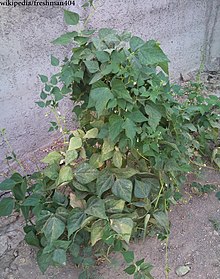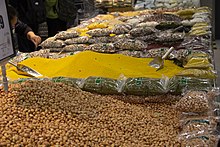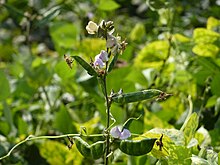Bean


A bean is the seed of several plants in the family
including boiling, frying, and baking, and are used in many traditional dishes throughout the world.Terminology
The word "bean" and its Germanic
Seeds called "beans" are often included among the crops called "pulses" (
Cultivation

Unlike the closely related pea, beans are a summer crop that needs warm temperatures to grow. Legumes are capable of nitrogen fixation and hence need less fertiliser than most plants. Maturity is typically 55–60 days from planting to harvest.[6] As the bean pods mature, they turn yellow and dry up, and the beans inside change from green to their mature colour.[clarification needed] Many beans are vines, as such the plants need external support, which may take the form of special "bean cages" or poles. Native Americans customarily grew them along with corn and squash (the so-called Three Sisters),[7] with the tall cornstalks acting as support for the beans.
In more recent times, the so-called "bush bean" has been developed which does not require support and has all its pods develop simultaneously (as opposed to pole beans which develop gradually).[8] This makes the bush bean more practical for commercial production.
History
This section needs additional citations for verification. (April 2022) |


Beans were an important source of
Beans are one of the longest-cultivated plants in history.
The oldest-known domesticated beans in the Americas were found in Guitarrero Cave, an archaeological site in Peru, and dated to around the second millennium BCE.[13] However, genetic analyses of the common bean Phaseolus show that it originated in Mesoamerica, and subsequently spread southward, along with maize and squash, traditional companion crops.[14]
Most of the kinds of beans commonly eaten today are part of the genus Phaseolus, which originated in the Americas. The first European to encounter them was
One well-documented use of beans by pre-Columbian people as far north as the Atlantic seaboard is the "Three Sisters" method of companion plant cultivation: Many tribes would grow beans together with maize or "corn", and squash. The corn would not be planted in rows as is done by European agriculture, but in a checkerboard/hex fashion across a field, in separate patches of one to six stalks each. Beans would be planted around the base of the developing stalks, and would vine their way up as the stalks grew. All American beans at that time were vine plants; "bush beans" were cultivated more recently. The cornstalks would work as a
Beans were cultivated across Chile in Pre-Hispanic times, likely as far south as Chiloé Archipelago.[17]
Dry beans come from both Old World varieties of broad beans (fava beans) and New World varieties (kidney, black, cranberry, pinto, navy/haricot).
Common genera and species

Most of the foods we call "beans", "legumes", "lentils" and "pulses" belong to the same family, Fabaceae ("leguminous" plants), but are from different genera and species, native to different homelands and distributed worldwide depending on their adaptability.[18] Many varieties are eaten both fresh (the whole pod, and the immature beans may or may not be inside) or shelled (immature seeds, mature and fresh seeds, or mature and dried seeds). Numerous legumes look similar, and have become naturalized in locations across the world, which often lead to similar names for different species.
| Genus | Species and Common Varieties | Probable Homeland | Distribution, Cultivation and Climate | Notes |
|---|---|---|---|---|
| Phaseolus | P. vulgaris: Kidney Bean, Pinto Bean, Navy Bean (Cannellini, Haricot Beans/French Beans/Pole Beans/Bush Beans), Black Beans, Borlotti Beans
P. coccineus: Runner Beans, Flat Beans P. acutifolius: Tepary Bean |
The Americas | Tropical, Subtropical, Warm Temperate | Certain varieties contain high levels of toxic phytohemagglutinin. Requires soaking and then cooking at or above 100C for a minimum of 30 minutes, and ideally much longer.[19][20][21] |
Pisum
|
Mediterranean
|
Subtropical, Temperate, Occasionally Cool Tropical | ||
| Vigna | V. radiata: Mung Bean
V. mungo: Urad V. unguiculata (Cowpeas): Yardlong bean, Black-eyed Peas V. aconitifolia: Moth bean
|
Mostly South Asia | Equatorial, Pantropical, Warm Subtropical, Hot Temperate | |
| Cajanus | C. cajan: Pigeon Pea | Indian Subcontinent | Pantropical, Equatorial | |
Lens
|
L. culinaris (Lentils): Red Lentil, Green Lentil, Puy Lentil
|
Near East/Levant | Temperate, Subtropical, Cool Tropical | |
| Cicer | C. arietinum: Chickpeas (Garbanzo Beans) | Turkey/Levant/Near East | Temperate, Subtropical, Cool Tropical | |
| Vicia | V. faba: Fava Beans (Broad Beans)
V. ervilia: Bitter vetch V. sativa: Common vetch |
Near East | Subtropical, Temperate | Causes Favism in those susceptible.[22][23] |
| Arachis | A. hypogaea: Peanut (Groundnut) | South America | Warm Subtropical, Cool Tropical | |
| Glycine | G. max : Soybean
|
East Asia | Hot Temperate, Subtropical, Cool Tropical | |
| Macrotyloma | M. uniflorum: Horsegram | South Asia | Tropical, Subtropical | |
| Mucuna | M. pruriens: Velvet Bean | Tropical Asia and Africa | Tropical, Warm Subtropical | Contains L-DOPA,[24] and smaller amounts of other psychoactive compounds. Can also cause itching and rashes on contact. |
| Lupinus | L. albus: White Lupin
L. mutabilis: Tarwi/Andean Lupin |
The Mediterranean, Balkans, Levant (albinus), The Andes (mutabilis) | Subtropical, Temperate | Requires prolonged soaking in the correct way to reduce toxic compounds.[25] |
| Ceratonia | C. siliqua : Carob bean
|
Mediterranean, Middle East | Subtropical, Arid Subtropical, Hot Temperate | |
| Canavalia | C. gladiata: Sword Bean
C. ensiformis: Jack Beans |
South Asia or Africa (C. gladiata), Brazil and South America (C. Ensiformis) | Tropical | |
| Cyamopsis | C. tetragonoloba : Guar Bean
|
Africa or South Asia | Tropical, Semi-Arid | Source of Guar gum |
| Lablab | L. purpureus : Hyacinth Bean/Lablab Bean
|
South Asia, Indian Subcontinent or Africa | Tropical | |
| Psophocarpus | P. tetranoglobulus : Winged Bean
|
New Guinea | Tropical, Equatorial
|
|
| Clitoria | C. ternatea: Butterfly Pea | Equatorial and Tropical Asia | Tropical, Subtropical | Flowers used as a natural food colouring |
| Lathyrus | L. sativus: Grass Pea
L. tuberosus: Tuberous Pea |
Balkans, India or Asia | Subtropical | Can cause Lathyrism if used as staple.[26][27] |
| Trifolium | T. repens: White Clover
T. pratense: Red Clover |
Europe and Central Asia | Subtropical, Temperate | |
| Medicago | M. sativa: Alfalfa | Central Asia | Subtropical, Temperate | |
| Melilotus | M. officinalis: Sweet Clover | Europe and Central Asia | Subtropical, Temperate | Contains Coumarins, an important class of perfume ingredients. Coumarin is also a blood thinner. |
| Tamarindus | T. indica: Tamarind | Africa | Tropical, Subtropical |
Bean seed storage
As of 2023, the Norwegian Svalbard Global Seed Vault holds more than 40,000 accessions of Phaseolus bean species.[28]
Properties
Nutrition
| Nutritional value per 100 g (3.5 oz) | |
|---|---|
| Energy | 31 kcal (130 kJ) |
6.97 g | |
| Sugars | 3.26 g |
| Dietary fiber | 2.7 g |
0.22 g | |
1.83 g | |
Niacin (B3) | 5% 0.734 mg |
| Vitamin B6 | 8% 0.141 mg |
| Folate (B9) | 8% 33 μg |
| Vitamin C | 14% 12.2 mg |
| Minerals | Quantity %DV† |
| Calcium | 3% 37 mg |
| Iron | 6% 1.03 mg |
| Magnesium | 6% 25 mg |
| Phosphorus | 3% 38 mg |
| Potassium | 7% 211 mg |
| Sodium | 0% 6 mg |
| Zinc | 2% 0.24 mg |
| Other constituents | Quantity |
| Water | 90.3 g |
| †Percentages estimated using US recommendations for adults,[29] except for potassium, which is estimated based on expert recommendation from the National Academies.[30] | |
Raw green beans are 90% water, 7%
in significant content (table).Antinutrients
Many types of bean like kidney bean contain significant amounts of antinutrients that inhibit some enzyme processes in the body. Phytic acid and phytates, present in grains, nuts, seeds and beans, interfere with bone growth and interrupt vitamin D metabolism. Pioneering work on the effect of phytic acid was done by Edward Mellanby from 1939.[31][32]
Health concerns
Toxins
Some kinds of raw beans contain a harmful, tasteless toxin: the
Cooking beans, without bringing them to a boil, in a
Bean poisoning is not well known in the medical community, and many cases may be misdiagnosed or never reported; figures appear not to be available. In the case of the UK National Poisons Information Service, available only to health professionals, the dangers of beans other than red beans were not flagged as of 2008[update].[35]
Bacterial infection from bean sprouts
It is common to make
Flatulence
Many edible beans, including broad beans, navy beans, kidney beans and soybeans, contain oligosaccharides (particularly raffinose and stachyose), a type of sugar molecule also found in cabbage. An anti-oligosaccharide enzyme is necessary to properly digest these sugar molecules. As a normal human digestive tract does not contain any anti-oligosaccharide enzymes, consumed oligosaccharides are typically digested by bacteria in the large intestine. This digestion process produces gases, such as methane as a byproduct, which are then released as flatulence.[40][41][42][43]
Production

The production data for legumes are published by FAO in three categories:
- Pulses dry: all mature and dry seeds of leguminous plants except soybeans and groundnuts.
- Oil crops: soybeans and groundnuts.
- Fresh vegetable: immature green fresh fruits of leguminous plants.
The following is a summary of FAO data.[44]
| Crops [FAO code][45] |
1961 | 1981 | 2001 | 2015 | 2016 | Ratio 2016 /1961 |
Remarks |
|---|---|---|---|---|---|---|---|
| Total pulses (dry) [1726] | 40.78 | 41.63 | 56.23 | 77.57 | 81.80 | 2.01 | Per capita production had decreased. (Population increase was 2.4×) |
| Oil crops (dry) | |||||||
| Soybeans [236] | 26.88 | 88.53 | 177.02 | 323.20 | 334.89 | 12.46 | Drastic increase driven by the demand for animal feeds and oil. |
| Groundnuts, with shell [242] | 14.13 | 20.58 | 35.82 | 45.08 | 43.98 | 3.11 | |
| Fresh vegetables (80–90% water) | |||||||
| Beans, green [414] | 2.63 | 4.09 | 10.92 | 23.12 | 23.60 | 8.96 | |
| Peas, green [417] | 3.79 | 5.66 | 12.41 | 19.44 | 19.88 | 5.25 | |
Main crops of "Pulses, Total (dry)" are "Beans, dry [176]" 26.83 million tons, "Peas, dry [187]" 14.36 million tons, "Chick peas [191]" 12.09 million tons, "Cow peas [195]" 6.99 million tons, "Lentils [201]" 6.32 million tons, "Pigeon peas [197]" 4.49 million tons, "Broad beans, horse beans [181]" 4.46 million tons. In general, the consumption of pulses per capita has been decreasing since 1961. Exceptions are lentils and cowpeas.

| Country | 2016 | Share | Remarks | |
|---|---|---|---|---|
| Total | 81.80 | 100% | ||
| 1 | India | 17.56 | 21.47% | |
| 2 | Canada | 8.20 | 10.03% | |
| 3 | Myanmar | 6.57 | 8.03% | |
| 4 | China | 4.23 | 5.17% | |
| 5 | Nigeria | 3.09 | 3.78% | |
| 6 | Russia | 2.94 | 3.60% | |
| 7 | Ethiopia | 2.73 | 3.34% | |
| 8 | Brazil | 2.62 | 3.21% | |
| 9 | Australia | 2.52 | 3.09% | |
| 10 | USA | 2.44 | 2.98% | |
| 11 | Niger | 2.06 | 2.51% | |
| 12 | Tanzania | 2.00 | 2.45% | |
| Others | 24.82 | 30.34% |
The world leader in production of dry beans (Phaseolus spp),[47] is India, followed by Myanmar (Burma) and Brazil. In Africa, the most important producer is Tanzania.[48]
| Country | Production (tonnes) |
Footnote |
|---|---|---|
| 5,460,000 | F | |
| 3,053,012 | ||
| 3,035,290 | A | |
| 1,495,180 | * | |
| 1,281,586 | ||
| 1,267,648 | F | |
| 1,056,071 | ||
| 774,366 | F | |
| 633,823 | * | |
| 603,980 | ||
| World | 27,545,942 | A |
No symbol = official figure, P = official figure, F = FAO estimate, * = unofficial/semi-official/mirror data, C = calculated figure A = aggregate (may include official, semi-official or estimates)
Source:
See also
- Baked beans
- Jelly beans
- Mexican jumping bean
- List of bean soups
- Fassoulada– a bean soup
- List of edible seeds
- List of legume dishes
- Beans, Beans, the Musical Fruit
References
- ^ "Beans and peas are unique foods | ChooseMyPlate". www.choosemyplate.gov. Retrieved 24 January 2020.
- ^ Clark, Mellisa. "How to Cook Beans". New York Times Cooking. Retrieved 3 January 2020.
- ^ a b c Merriam-Webster, Merriam-Webster's Collegiate Dictionary, Merriam-Webster, archived from the original on 10 October 2020, retrieved 3 May 2016[page needed]
- ^ Houghton Mifflin Harcourt, The American Heritage Dictionary of the English Language, Houghton Mifflin Harcourt, archived from the original on 25 September 2015, retrieved 3 May 2016.
- ^ a b "Definition And Classification Of Commodities (See Chapter 4)". FAO, United Nations. 1994. Archived from the original on 12 October 2018. Retrieved 5 July 2012.
- ISBN 9781928914600. Retrieved 18 November 2017 – via Google Books.
- ISBN 9781616731267. Retrieved 18 November 2017 – via Google Books.
- ^ "The Germination Of a Bean" (PDF). Microscopy-uk.org.uk. Archived (PDF) from the original on 9 October 2022. Retrieved 18 November 2017.
- ^ Kaplan, pp. 27 ff
- S2CID 34052655.
- ISBN 0199549060, p. 114.
- ^ "And as in some great threshing-floor go leaping From a broad pan the black-skinned beans or peas." (Iliad xiii, 589).
- ISBN 978-0-205-40621-0.
- PMID 22393017.
- ^ Kaplan, p. 30: Domestication, besides involving selection for larger seed size, also involved selection for pods that did not curl and open when ripe, scattering the beans they contained.
- ^ Kaplan, p. 30
- ISBN 9789569120022.
- ^ Boston, 677 Huntington Avenue; Ma 02115 +1495‑1000 (28 October 2019). "Legumes and Pulses". The Nutrition Source. Retrieved 7 April 2022.
{{cite web}}: CS1 maint: numeric names: authors list (link) - ISSN 0084-7747.
- PMID 29270365.
- ISSN 1094-2912.
- PMID 4541143.
- S2CID 221182334.
- PMID 22707835.)
{{cite journal}}: CS1 maint: DOI inactive as of January 2024 (link - PMID 32626161.
- PMID 8684587.
- PMID 8472656.
- ^ "The seeds". Svalbard Global Seed Vault, Norwegian Ministry of Agriculture and Food. 2023. Retrieved 5 November 2023.
- ^ United States Food and Drug Administration (2024). "Daily Value on the Nutrition and Supplement Facts Labels". Retrieved 28 March 2024.
- )
- PMID 16747083.
- ^ Ramiel Nagel (26 March 2010). "Living With Phytic Acid - Weston A Price". The Weston A Price Foundation. Retrieved 23 January 2016.
- ^ "Natural toxins in food". www.who.int. Retrieved 7 April 2022.
- ^ Bad Bug Book. United States Food and Drug Administration. Archivedfrom the original on 9 July 2009. Retrieved 11 July 2009.
- ^ a b Vicky Jones (15 September 2008). "Beware of the beans: How beans can be a surprising source of food poisoning". The Independent. Retrieved 23 January 2016.
- ISSN 1365-2621.
- ^ Summary: Fermentation 'improves nutritional value of beans' Archived 22 May 2013 at the Wayback Machine (Sub Saharan Africa page, Science and Development Network website). Paper: Influence of natural and controlled fermentations on α-galactosides, antinutrients and protein digestibility of beans (Phaseolus vulgaris L.)
- ^ "Sprouts: What You Should Know". Foodsafety.gov. Retrieved 23 January 2016.
- ^ "Shiga toxin-producing E. coli (STEC): Update on outbreak in the EU (27 July 2011, 11:00)". European Centre for Disease Prevention and Control. 27 July 2011. Archived from the original on 15 March 2017.
- ^ "Health | Experts make flatulence-free bean". BBC News. 25 April 2006. Archived from the original on 31 March 2009. Retrieved 25 February 2009.
- ^ "Flatulence – Overview – Introduction". Nhs.uk. Archived from the original on 21 February 2009. Retrieved 25 February 2009.
- ISBN 978-0684843285.
Many legumes, especially soy, navy and lima beans, cause a sudden increase in bacterial activity and gas production a few hours after they're consumed. This is because they contain large amounts of carbohydrates that human digestive enzymes can't convert into absorbable sugars. These carbohydrates therefore leave the upper intestine unchanged and enter the lower reaches, where our resident bacterial population does the job we are unable to do.
- ISBN 978-3-540-67466-5.
we do not possess any enzymes that are capable of breaking down larger sugars, such as raffinose etc. These 3, 4 and 5 ring sugars are made by plants especially as part of the energy storage system in seeds and beans. If these sugars are ingested, they can't be broken down in the intestines; rather, they travel into the colon, where various bacteria digest them – and in the process produce copious amounts of carbon dioxide gas
- ^ FAO STAT Production/Crops.
- ^ See Legume § Classification.
- ^ All legumes dry.
- ^ Dry beans does not include broad beans, dry peas, chickpea, lentil.
- ^ FAO Pulses and Derived Products Archived 7 December 2015 at the Wayback Machine.
- ^ "Major Food And Agricultural Commodities And Producers – Countries By Commodity". Fao.org. Archived from the original on 6 September 2015. Retrieved 2 February 2015.
Bibliography
- Kaplan, Lawrence (2008). "Legumes in the History of Human Nutrition". In DuBois, Christine; Tan, Chee-Beng; Mintz, Sidney (eds.). The World of Soy. NUS Press. pp. 27–. ISBN 978-9971-69-413-5. Retrieved 18 December 2012.
External links
- Everett H. Bickley Collection, 1919–1980 Archives Center, National Museum of American History, Smithsonian Institution.
- Discovery Online: The Skinny On Why Beans Give You Gas
- Fermentation improves nutritional value of beans
- Cook's Thesaurus on Beans
